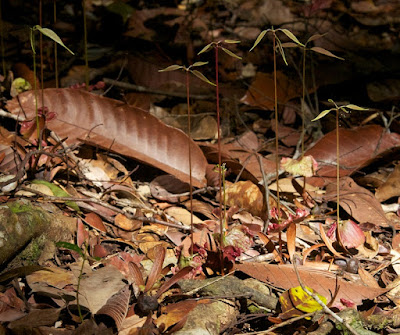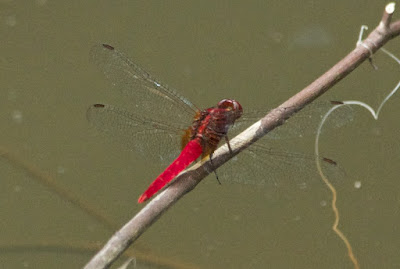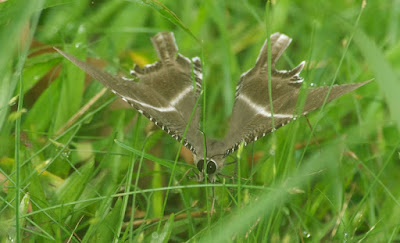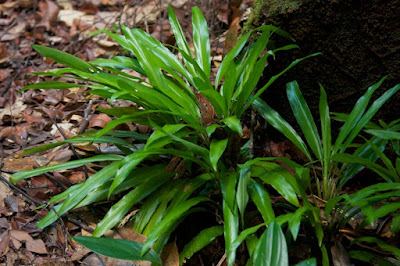The closest reasonably accessible bit of rainforest to Miri is to the south, in Lambir Hills National Park. This is also the closest place to Miri where you have a reasonable chance of seeing the elusive Bornean Bristlehead (Pityriasis gymnocephala), a unique and strange bird that I have been trying to find ever since I first set foot on the island. Unfortunately, "a reasonable chance" seems to mean that the birds are there fairly frequently, but leave the area in droves whenever I pay a visit. The morning of January 29, 2014, was no different.
In fact, on this particular visit birds of any kind seemed particularly scarce, perhaps because it was more than unusually hot. The only bird that let me get close enough to photograph it was this Bornean Brown Barbet (Caloramphus fuliginosus), right outside the park headquarters, as soon as I arrived. This is not the world's best photograph, but it does show the brick-orange throat that distinguishes this recently-separated species from the Malay Brown Barbet (C. hayii) of Peninsular Malaysia, Sumatra and Thailand.
As is often and often the case, it was easier to see wildlife in the open areas around park headquarters that within the forest itself. That included a few dragonflies that hang around a large pond near the park entrance; this one is a male Rhodothemis rufa.
The common and widespread Banded Swallowtail (Papilio demoleon) is another insect that prefers age and second growth to the forest interior.
Lyssa zampa is not a butterfly, but a moth. It belongs to the family Uraniidae, famous for containing a number of large and extremely colorful insects that look like swallowtail butterflies and, like them, fly by day. Lyssa, however, is primarily nocturnal, and I think this one was simply caught out trying to find a roost.
The park staff told me that the last time they had seen Bristleheads was at the top of a trail looping through the interior of the forest. I was not optimistic (correctly, as it turned out) but I shouldered my camera and monopod and set off along what turned out to be a rather steep climb. Once inside the forest, I began to see butterflies that prefer the darkness under the canopy to the open air. The Archduke (Lexias pardalis) is a common example.
The Malayan Owl (Neorina lowii) is much less common; indeed, this is the first time I can recall seeing one. Like many the invalid butterflies of the forest interior, it feeds on rotting fruit; many such butterflies visit flowers only rarely, if at all.
There are a huge number of nearly indistinguishable butterflies on the oakblue genus Arhopala, and I will leave it to more experienced people than I to come up with a name for this one. Some 90 Arhopalas are known from Borneo alone. Oakblue caterpillars feed on Macaranga, a genus of plants often vigorously defended by particularly ferocious stinging ants. According to a study carried out on three species in Sarawak, the caterpillars of at least some Arhopala caterpillars get around this problem either by carrying chemicals in their skins (or cuticles) that mimic hydrocarbons produced by the ants themselves (so that the ants fail to attack them), or by bribing the ants with sweet droplets of honeydew.
The absence of birds did leave me free to pay attention to other things around me, including the variety of plant life. I believe that the plant in the lower photograph is an orchid of some sort, but it was not, unfortunately, in bloom.
Rainforests in Southeast Asia are dominated by the enormous trees in the family Dipterocarpaceae, named for their two- (or sometimes four-) winged fruits. Dipterocarps flower very irregularly, sometimes only once a decade. In Borneo flowering is triggered by El Niño events, and when it happens the forest floor can be carpeted with dipterocarp fruits of several species. This must have been a flowering year at Lambir Hills, because they lay underfoot wherever I walked.
From them sprouted particularly attractive seedlings, only a few destined to develop into forest giants.
I continued around the trail, climbing to where the Bristleheads used to be (but weren't), and then circling down again while lines of travelling termites crossed the forest floor....
and occasional, solitary Giant Forest Ants (Camponotus gigas) strode over the dead leaves, signs of life on an otherwise quiet forest day.
























Hi Ronald. I fear that the absence of birds is the result of relentless poaching that has been going on in the last decades in Lambir. Malaysian poachers are seen in increasing numbers across the border in Brunei and I suspect this is because their own larder is getting empty. For bristleheads the nearby forests of the lower Belait district in brunei would provide a much better chance!
ReplyDelete